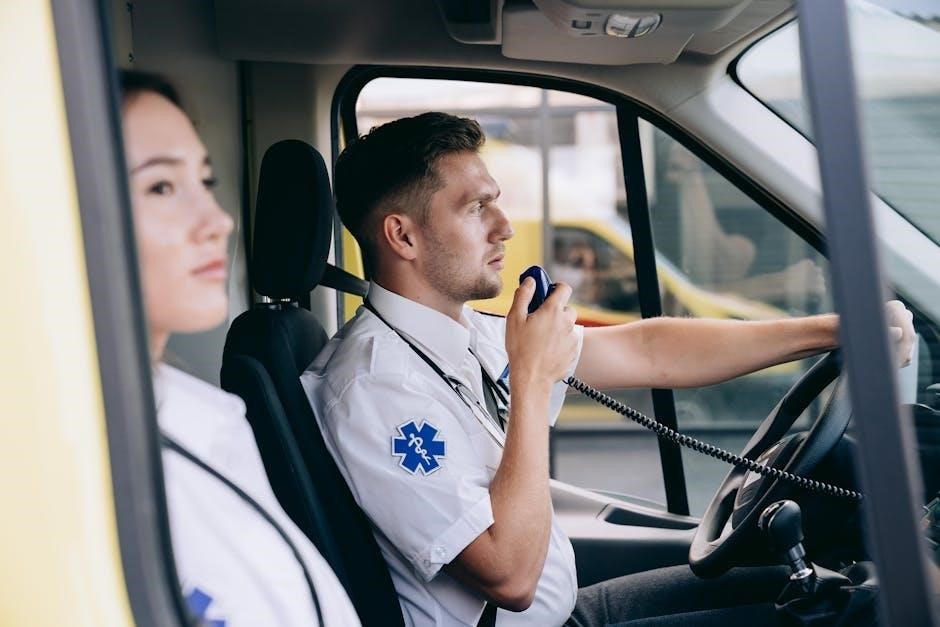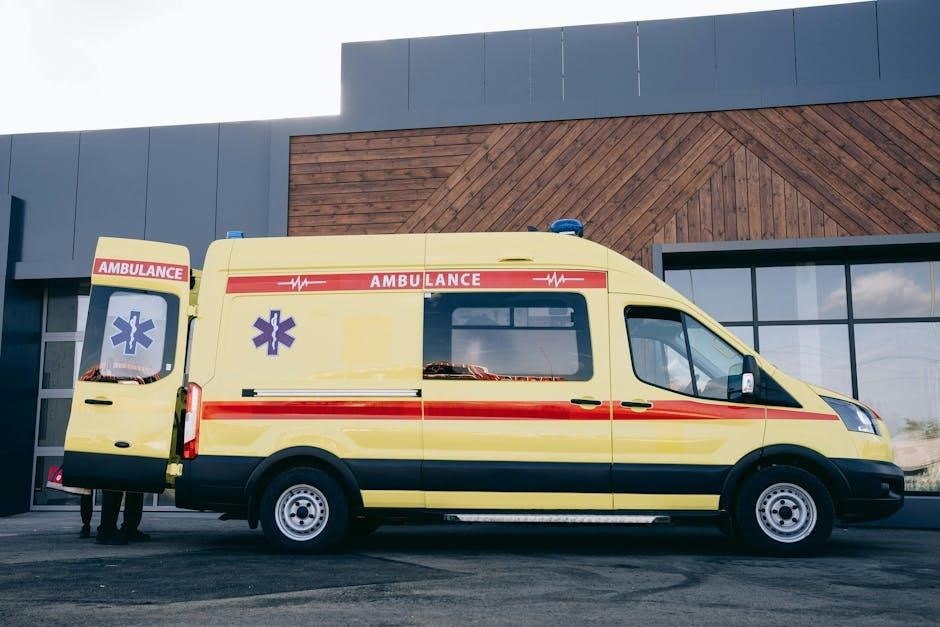
St John First Aid Quiz Questions and Answers PDF: An Overview
St John Ambulance offers vital first aid training, and their quiz questions and answers, often available in PDF format, provide valuable resources. These materials help individuals test their knowledge and prepare for real-life emergency situations, enhancing their ability to provide effective assistance.
Importance of First Aid Knowledge
First aid knowledge is paramount for everyone, equipping individuals with the skills to provide immediate assistance in emergencies. It empowers individuals to act decisively and confidently when faced with injuries or sudden illnesses, potentially saving lives before professional help arrives. Understanding basic first aid principles enables one to assess situations quickly, prioritize actions, and administer appropriate care. This knowledge extends beyond personal safety, fostering a sense of community responsibility and preparedness.
Moreover, first aid training enhances awareness of potential hazards and promotes preventative measures, reducing the likelihood of accidents. Possessing first aid skills builds confidence and reduces panic in stressful situations, allowing for clearer thinking and more effective intervention. Whether it’s managing bleeding, performing CPR, or treating burns, first aid knowledge is an invaluable asset. Ultimately, being equipped with first aid skills makes individuals valuable assets in any environment, capable of providing crucial support during critical moments.
St John Ambulance: A Leading Provider
St John Ambulance stands as a leading provider of first aid training and resources globally, renowned for its commitment to equipping individuals with life-saving skills. With a rich history and a dedication to excellence, St John Ambulance has consistently set the standard for first aid education and emergency response. Their comprehensive training programs, developed by medical experts, cover a wide range of topics, ensuring participants receive the most up-to-date and effective instruction.
The organization’s extensive network of volunteers and professionals delivers accessible and engaging courses, catering to diverse learning styles and needs. St John Ambulance’s commitment extends beyond training, as they actively participate in community outreach, providing first aid services at public events and supporting local initiatives. Through their unwavering dedication, St John Ambulance continues to empower individuals and communities with the knowledge and skills necessary to respond confidently and effectively in emergency situations, solidifying their position as a trusted leader in first aid.

Key Areas Covered in St John First Aid Quizzes
St John First Aid quizzes typically cover essential areas like emergency scene management, CPR and defibrillation, managing bleeding, and the treatment of burns. These key areas ensure comprehensive preparedness for various emergency scenarios, crucial for effective first aid response.
Emergency Scene Management
Emergency scene management is a critical initial step in first aid, focusing on ensuring the safety of both the responder and the casualty. It involves assessing the scene for potential hazards, such as traffic, fire, or hazardous materials. A key aspect is identifying the mechanism of injury or nature of illness to understand the potential scope of the emergency.
Effective scene management also includes establishing a safe perimeter and, if necessary, contacting emergency services for additional support. Prioritizing safety helps prevent further injuries and ensures a clear path for providing care. First aiders must quickly evaluate the situation to make informed decisions.
This encompasses determining the number of casualties and initiating triage if multiple people are involved. Clear communication with bystanders is essential, delegating tasks like calling for help or gathering supplies. The goal is to create a controlled and secure environment.
By following a structured approach to emergency scene management, first aiders can effectively minimize risks, protect themselves and others, and deliver appropriate care efficiently. It’s about thinking clearly under pressure.
CPR and Defibrillation (AED)
CPR, or cardiopulmonary resuscitation, is a life-saving technique used when someone’s heart has stopped beating. It involves chest compressions and rescue breaths to circulate blood and oxygen to the brain and other vital organs. Proper CPR technique is essential for effectiveness. Knowing the correct hand placement, compression depth, and rate are crucial.
Defibrillation, often using an AED (Automated External Defibrillator), is used to deliver an electrical shock to the heart in cases of certain life-threatening arrhythmias. AEDs analyze the heart rhythm and provide voice prompts to guide the user through the process. Early defibrillation significantly increases the chances of survival.
CPR and defibrillation are often performed together, forming a critical link in the chain of survival. Effective CPR can buy time until an AED is available. Regular training and practice are vital to ensure proficiency in these techniques. Understanding when and how to use these tools can make a life-changing difference. These skills are invaluable for everyone.
Managing Bleeding and Shock
Controlling bleeding is a crucial first aid skill, as excessive blood loss can quickly lead to shock and death. The primary method for managing bleeding is to apply direct pressure to the wound using a clean cloth or dressing. If the bleeding is severe or does not stop with direct pressure, elevation of the injured limb can help reduce blood flow.
Shock is a dangerous condition that occurs when the body isn’t getting enough blood flow. It can be caused by a variety of factors, including severe bleeding, trauma, or allergic reactions. Signs of shock include rapid heartbeat, shallow breathing, pale skin, and confusion.
Managing shock involves addressing the underlying cause, such as controlling bleeding, and providing supportive care. This includes keeping the person warm and comfortable, elevating their legs (unless there’s a head injury), and monitoring their vital signs. Prompt recognition and treatment of both bleeding and shock are critical for improving outcomes. Seeking professional medical help is always the next step.
Treatment of Burns and Scalds
Burns and scalds are common injuries that require immediate and appropriate first aid. The severity of a burn depends on the depth of the burn and the extent of the body surface area affected. Immediate cooling of the burn area is crucial to minimize tissue damage. This is best achieved by holding the affected area under cool running water for at least 20 minutes.
Remove any clothing or jewelry near the burn, unless it is stuck to the skin. Do not apply ice, butter, or any other home remedies, as these can worsen the injury and increase the risk of infection. Cover the burn with a sterile, non-adhesive dressing to protect it from contamination.
For minor burns, pain relief can be provided with over-the-counter pain relievers. However, for more severe burns, it is essential to seek medical attention. Signs of a severe burn include blistering, charring, involvement of a large area of the body, or burns to the face, hands, feet, or genitals.

Where to Find St John First Aid Quiz Questions and Answers (PDF)
To access St John Ambulance first aid quiz questions and answers in PDF format, begin by checking their official website. Educational platforms and study resources may also offer these valuable learning materials.
St John Ambulance Official Website
The official St John Ambulance website stands as a primary and reliable source for obtaining first aid quiz questions and answers in PDF format. This website often features a dedicated section for training resources, where you can find study materials specifically designed to aid learners in preparing for first aid certifications.
Navigating to the training or education portion of the site will likely reveal downloadable PDFs containing practice quizzes, sample questions, and comprehensive answer keys. These resources are meticulously crafted to align with St John Ambulance’s established first aid protocols and guidelines, ensuring accuracy and relevance.
Furthermore, the official website serves as a hub for updates and revisions to first aid practices, so accessing materials directly from this source guarantees that you are utilizing the most current and evidence-based information available. This approach enhances the effectiveness of your learning and preparedness.

Educational Platforms and Study Resources
Beyond the official St John Ambulance website, numerous educational platforms and study resources offer first aid quiz questions and answers, often in PDF format. Websites like Quizlet provide flashcards and practice quizzes created by other users, which can be helpful for quick reviews and self-testing.
Additionally, various online learning platforms that host first aid courses frequently include downloadable study guides and practice materials containing sample questions and answers. These resources aim to reinforce learning and prepare students for certification exams.
When searching for these materials, it’s crucial to ensure that the content aligns with current first aid guidelines and is sourced from reputable providers or instructors. This ensures the accuracy and reliability of the information.
Moreover, consider exploring libraries, local community centers, and training organizations, as they may offer printed study guides or recommend specific online resources that contain relevant quiz questions and answers in PDF format.

Benefits of Using St John First Aid Quiz Questions and Answers
Utilizing St John First Aid quiz questions and answers offers numerous benefits for individuals seeking to enhance their first aid knowledge and skills. These resources provide a structured approach to learning and reinforcing critical concepts. By working through the quizzes, individuals can identify areas where their understanding may be lacking and focus their studies accordingly.
The quiz format promotes active learning, encouraging users to engage with the material rather than passively reading through it. This active engagement leads to improved retention and a deeper understanding of the subject matter. Furthermore, the availability of answers allows for immediate feedback, enabling users to correct misunderstandings and solidify their knowledge.
Regularly using these quiz questions and answers can significantly boost confidence in one’s ability to respond effectively in emergency situations. This increased confidence can translate into quicker and more decisive action when providing first aid, potentially making a life-saving difference. Ultimately, these resources empower individuals to become more prepared and capable first responders.